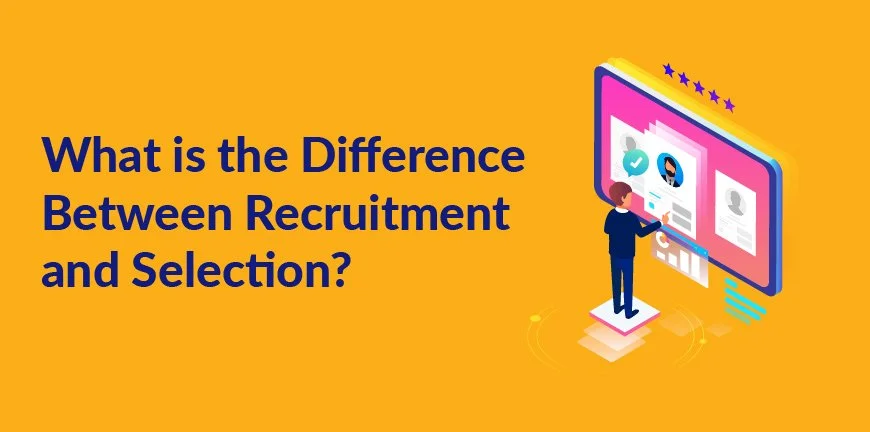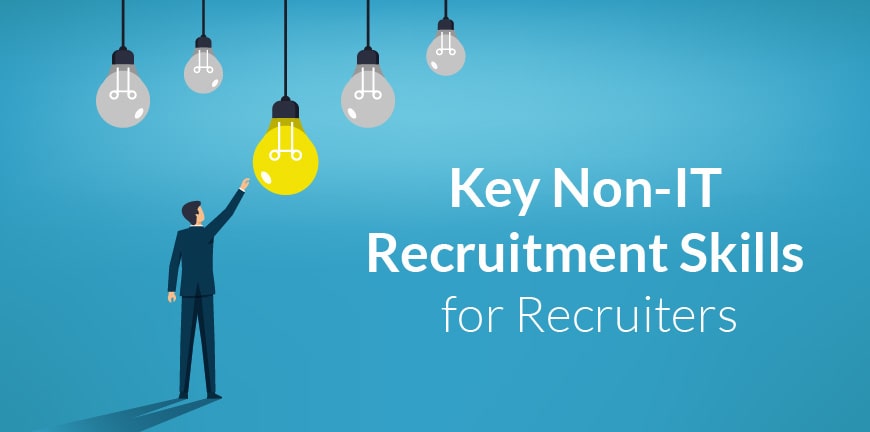
Top 8 Banking and Financial Technology Trends in 2025
08/12/2024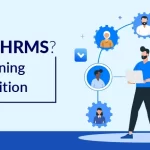
What is HRMS? Meaning, Definition, Objectives, Functions
11/12/2024- What is Recruitment?
- What are the steps in recruitment?
- What is Selection?
- What are the steps in selection?
- Recruitment vs Selection: Key Differences
- What are the Recruitment and Selection Examples?
- What is the Importance of Recruitment and Selection in HRM?
- What is the Business Impact of a Strong Hiring Process?
- What are the Challenges in Recruitment and Selection?
- What are the Best Practices for Recruitment and Selection?
- How Technology Is Transforming Recruitment and Selection in 2026?
- What are the Future Trends in Recruitment and Selection?
- Are you looking for a Recruitment Partner?
- Key Takeaways
- Frequently Asked Questions (FAQ)
“Hiring good people is hard. Hiring great people is brutally hard. And yet, nothing matters more.”- Jack Welch (Former CEO, General Electric).
In India’s fast-evolving job market, great teams are what truly set successful organizations apart. Recruitment and selection play a vital role in this journey. Recruitment helps attract skilled candidates who align with your company’s goals, while selection ensures you choose the perfect fit for each role. Together, they create a powerful hiring strategy that fuels growth, strengthens culture, and drives long-term success.
Let’s discuss all aspects in detail related to recruitment and selection so that companies can make the necessary tweaks to make the hiring process even more effective.
What is Recruitment?
Recruitment is a process of searching for the right candidates and nudging them to apply for the open position. The main goal of recruitment is to search for and attract the right individuals with the right qualifications to pick the best one for the job. It is an ongoing process that aims at attracting a large pool of candidates for the job by communicating the open roles through different recruitment channels.
5 key objectives of recruitment in HRM
- To attract a large pool of qualified candidates to fill current & future job vacancies efficiently and effectively.
- To create awareness about job opportunities & promote the organisation as an employer of choice among potential candidates.
- To ensure timely hiring that aligns with workforce planning & organisational growth requirements.
- To reduce hiring costs while maintaining the quality & suitability of candidates recruited.
- To build a sustainable talent pipeline that supports long-term organisational success & employee retention.
What are the steps in recruitment?
The recruitment process is a comprehensive process that involves several steps to find potential candidates for further assessment. The process goes something like this-
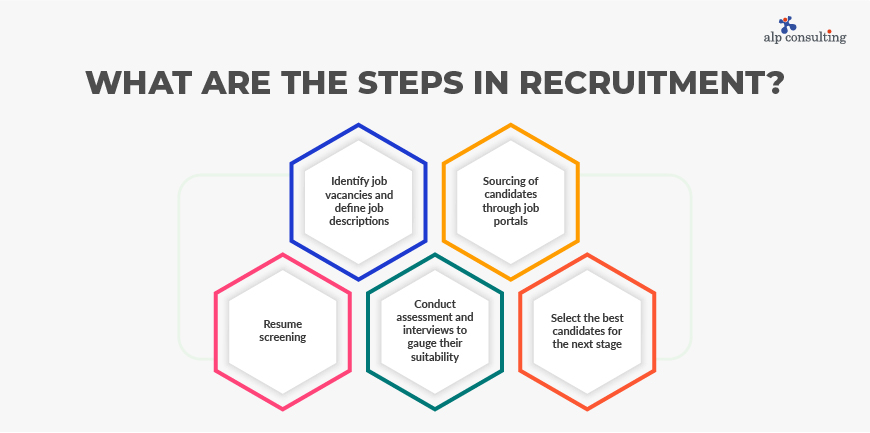
1. Identify job vacancies and define job descriptions
This is the first step in the recruitment process that starts with figuring out the need for new employees. The HR and the hiring managers together create job descriptions that define the roles, responsibilities and skills, qualifications, etc required for the open positions.
2. Sourcing of candidates through job portals
Upon establishing the job vacancies and creating the job descriptions, recruiters like Alp Consulting use various channels to attract candidates. The jobs are posted on various portals, social media platforms, and platforms for recruitment advertisements.
3. Resume screening
Once the job is posted out there, there will be applications flowing on from potential candidates. Recruiters must then review these applications and pick out the resumes with candidates who have the most relevant skills and qualifications, and move the list further for evaluation.
4. Conduct assessment and interviews to gauge their suitability
After a careful assessment of the candidates, recruiters produce a list of candidates that are best suited for the role. These candidates are invited for interviews where their skills and qualifications are assessed to check their suitability for the role. The interview may include multiple rounds to assess the candidate’s abilities.
5. Select the best candidates for the next stage
Post the thorough assessment and comparison of all the potential candidates, the most suitable ones are chosen to go through the next stage, which involves additional assessments, reference checks, or a final interview before the job offer is made.
On the other hand, the selection process involves unique steps that can help organizations make the final decision about making their hiring decisions. Here are 4 important steps in selection:
What is Selection?
Selection is the phase of the hiring process that comes after the recruitment stage, where there is a careful evaluation of the potential candidates and choosing the one that best suits the role. The selection process assesses the candidates’ qualifications, skills, experience, and cultural alignment with the organization through assessments, interviews, and reference checks.
5 key objectives of the selection process in HRM
- To identify and hire candidates who best match job requirements, organisational culture, & long-term goals.
- To ensure a fair, transparent, & unbiased selection process based on merit and competency.
- To minimise employee turnover by choosing candidates with strong job compatibility & motivation.
- To enhance workforce productivity by selecting individuals with the right skills, attitude, & potential.
- To comply with legal & ethical hiring standards while maintaining organisational integrity and professionalism.
What are the steps in selection?
The selection process involves several steps that can help organizations make the final decision about making their hiring decisions.
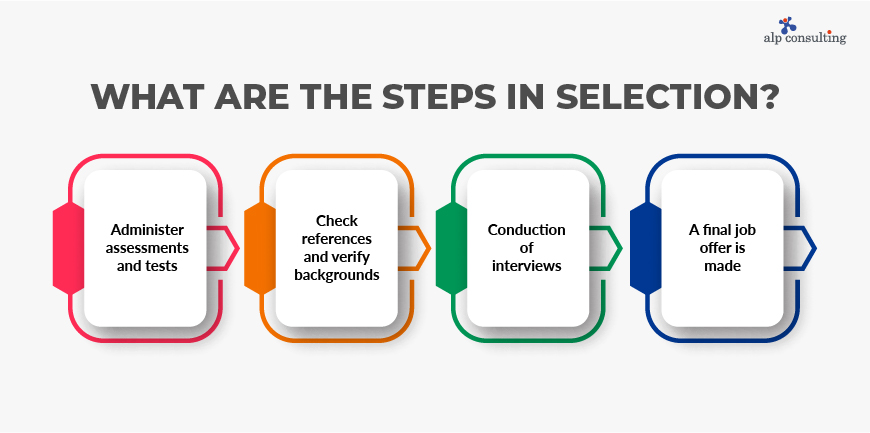
1. Administer assessments and tests
Candidates must undergo a variety of tests and assessments that can help the recruiters or the hiring managers gauge their skills and suitability for the role.
2. Check references and verify backgrounds
Employers carry out reference checks and background checks of the candidates by checking out their employment history and reaching out to their previous employers, who can validate the experience and other traits of the candidate during their tenure there.
3. Conduction of interviews
The shortlisted candidates are to go through interviews with stakeholders, departments, or senior management. They decide which one of these candidates will be the best suited for their open positions.
4. A final job offer is made
After completing all evaluations and assessments, the organization extends a formal job offer to the most suitable candidate, negotiating terms and conditions as needed.
Recruitment vs Selection: Key Differences
Recruitment and selection are two different functions and are implemented at various times during the hiring process. The stages of the recruitment and selection process involve distinct steps leading to the recruitment of the best candidate for the job.
To help you understand better about difference between recruitment and selection, here is a table that lists the points that carve out the differences. Let’s take a look.
Aspect |
Recruitment |
Selection |
| Definition | Target suitable candidates, introduce the open role, and get their attention | The list of gathered candidates is analysed through assessments and tests. |
| Aim | Attract a large pool of potential candidates with skills and qualifications that match the requirements of the open position | Filter out candidates from the list of potential candidates after a thorough assessment of skills and experience. |
| Process | Crafting a solid job description and posting it on job sites, social media, and other portals to attract a pool of candidates | Involves a thorough analysis of the candidates through background checks, various assessments, and suitable tests, determining their skills and selecting the best of the lot |
| Nature | Not expensive or time-consuming | It can be expensive and time-consuming. |
| Complexity | The vacancies are communicated, but no contracts are signed during this stage | The company must craft a contractual agreement between the firm and the selected candidate |
What are the Recruitment and Selection Examples?
Here are the top 5 recruitment and selection examples:
1. Campus Hiring Program
A tech company partners with universities to identify top graduates via aptitude tests & project-based assessments, ensuring a strong pipeline of entry-level talent.
2. Referral-Based Recruitment
A retail chain rewards employees for successful referrals, reducing hiring time & enhancing retention by leveraging trusted internal networks.
3. Competency-Based Interviews
A consulting firm evaluates candidates utilising behavioural interviews focused on analytical thinking, leadership, & problem-solving abilities aligned with company values.
4. Diversity Hiring Campaign
An MNC launches targeted initiatives to hire more women in leadership & tech roles, boosting workplace equality and innovation.
5. AI-Enabled Shortlisting
A financial services firm uses AI tools to screen resumes, match qualifications, & rank candidates for faster, data-backed selection decisions.
What is the Importance of Recruitment and Selection in HRM?
Here are 5 reasons that highlight the importance of recruitment and selection:
1. Organisational Productivity
Recruiting the right talent ensures optimal performance, innovation, & efficiency, directly impacting overall business outcomes and long-term success.
2. Cost Efficiency
Effective recruitment and selection in HRM reduces turnover, training expenses, & re-hiring costs, ensuring better utilisation of company resources and workforce stability.
3. Cultural Fit and Retention
Proper recruitment and selection methods ensure alignment between employee values and organisational culture, enhancing job satisfaction, commitment, & long-term retention.
4. Competitive Advantage
Hiring skilled, motivated employees strengthens the organisation’s market position & fosters agility in adapting to industry changes.
5. Legal and Ethical Compliance
Following a transparent and compliant recruitment and selection process prevents discrimination, legal disputes, & reputational risks, reinforcing corporate integrity.
What is the Business Impact of a Strong Hiring Process?
With a robust recruitment and selection process in hiring, organizations will be able to hire top talent, fostering future growth. Effective hiring enhances retention, productivity, and financial performance.
1. Development of a High-Quality Workforce
A well-thought-out and executed recruitment and selection process will ensure that you attract top talent from all regions in India. Additionally, hiring the right talent not only boosts your company’s productivity but also fosters a culture of excellence within the organization, which could be instrumental in the overall success of the organization.
2. Fosters a Positive Company Culture
Strategic recruitment and selection in HRM are key to business success. By ensuring that candidates possess both the necessary skills and a motivational alignment with the company’s goals and culture, organizations secure the ‘right fit.’ This alignment directly fosters a more engaged workforce, translating into measurable benefits like stronger collaboration, higher job satisfaction, & excellent retention rates.
3. Boosted Business Performance
A strategic recruitment and selection approach significantly impacts business performance. Hiring candidates with the right skills and cultural fit positively influences employee productivity, innovation, and motivation, resulting in improved overall business outcomes and a competitive edge in the market.
4. Enhanced Employee Retention and Reduced Turnover
A strong recruitment and selection process ensures the right match between candidates & roles, reducing early attrition and rehiring costs. When employees feel valued and well-placed, they are more likely to stay long-term, contributing to organizational stability, continuity, and sustained growth. Effective recruitment and selection minimizes disruption, strengthens team morale, & maintains consistent performance across departments.
5. Improved Employer Branding and Market Reputation
An efficient, transparent, and candidate-friendly hiring process positions your company as an employer of choice. Positive candidate experiences, whether hired or not, enhance your reputation in the job market, attracting high-quality professionals and industry recognition. Strong employer branding also supports future recruitment drives by drawing in skilled talent organically & reinforcing trust among current employees.
What are the Challenges in Recruitment and Selection?
Here are 5 key challenges faced by HR teams during recruitment and selection:
1. Talent Shortage
Finding qualified talent with the right blends of skills, experience, and cultural fit is becoming increasingly arduous via traditional recruitment and selection processes due to evolving job requirements & intense competition in the global talent market. According to a study by ManpowerGroup, over 77% of employers globally are reporting difficulty finding skilled talent that meets their business objectives.
2. High Recruitment Costs
Advertising vacancies, using recruitment platforms, conducting interviews, & onboarding processes incur significant costs, especially when multiple hiring rounds or replacements are initiated due to poor recruitment and selection methods. As per SHRM India, the average cost-per-hire in India is Rs. 50,000–Rs. 1,00,000, depending on role complexity.
3. Bias and Unconscious Discrimination
Recruiters may inadvertently favour certain candidates based on gender, age, or background. This leads to reduced workplace diversity, poor hiring decisions, & potential reputational or legal challenges for the organisation. According to the LinkedIn Global Recruiting Trends Report, 42% of recruiters admit unconscious bias impacts their hiring decisions.
4. Lengthy Hiring Process
Delays in screening, scheduling interviews, & decision-making can cause top candidates to lose interest or accept offers elsewhere. This results in lost opportunities & slower organisational growth. As per Glassdoor, the average time-to-hire in India is 35–45 days, typically causing talent drop-offs in most cases.
5. Retention and Turnover Issues
Hiring candidates who don’t align with company culture or role expectations often leads to higher attrition rates, diminished productivity & ROI, and increased recruitment cycle repetition costs. According to Harvard Business Review, 46% of new hires fail within 1.5 years due to poor fit or unmet expectations.
What are the Best Practices for Recruitment and Selection?
Here are 5 best practices that ensure the recruitment and selection process brings the best outcomes:
1. Structured Job Descriptions
Clearly define responsibilities, required skillsets, & role expectations to attract the right candidates at the right time and ensure transparency throughout the hiring process.
2. Data-Driven Screening
Use people and HR analytics & assessment tools to evaluate candidates objectively, improving accuracy, consistency, & fairness in selection decisions.
3. Employer Branding
Build a strong employer brand through authentic communication, employee testimonials, & career growth opportunities to attract top-tier talent.
4. Candidate Experience Enhancement
Provide clear communication, timely feedback, & smooth interview processes to create a positive and engaging candidate journey.
5. Diversity and Inclusion Focus
Deploy inclusive recruitment policies that encourage diverse hiring, fostering innovation, equality, and organizational resilience in dynamic business environments.
How Technology Is Transforming Recruitment and Selection in 2026?
Here are 5 ways technology is transforming the recruitment and selection process in 2026.”
1. AI-Powered Candidate Screening
Artificial intelligence in HR automates resume parsing & shortlisting, helping recruiters identify best-fit candidates faster with reduced confirmation bias & greater precision.
2. Virtual Reality (VR) Assessments
Companies will soon use VR simulations to test real-world job skills, providing immersive, experience-based evaluations for better candidate-role alignment.
3. Predictive Analytics
Data analytics tools forecast candidate success & turnover risk, helping organisations make evidence-based, long-term hiring decisions.
4. Chatbots for Engagement
AI-driven chatbots streamline candidate communication, answer FAQs, & improve overall responsiveness in high-volume recruitment environments.
5. Blockchain Verification
Blockchain technology ensures tamper-proof verification of credentials, education, & work history, enhancing trust and reducing fraudulent applications.
What are the Future Trends in Recruitment and Selection?
Here are 5 future trends in recruitment and selection that will reshape the hiring process in 2026.
1. Skill-Based Hiring
Employers will prioritise skills and potential over traditional degrees, enabling broader access to talent pools.
2. Hyper-Personalised Recruitment
AI will tailor job recommendations & engagement based on candidate profiles and behavioural data analytics.
3. Sustainability-Driven Recruitment
Companies will now attract eco-conscious talent by highlighting environmental, social, & governance (ESG) initiatives.
4. Remote-First Hiring
Global talent acquisition will rise as remote & hybrid work models become long-term norms.
5. Continuous Candidate Nurturing
Recruitment in HRM will evolve into relationship management, maintaining engagement with potential talent for future opportunities.
Are you looking for a Recruitment Partner?
Choose ALP Consulting, a trusted recruitment partner with over 3 decades of industry expertise & proven success across multiple sectors. We deliver end-to-end talent acquisition solutions, combining technology, human insight, & market intelligence to help you find the right talent faster.
Our deep understanding of industry-specific needs, extensive candidate network, & commitment to compliance ensure seamless, cost-effective hiring. With ALP Consulting, you gain a partner dedicated to driving workforce excellence & business growth.
Key Takeaways
- Effective recruitment and selection ensure hiring the right talent, driving productivity, retention, & organizational success.
- Recruitment attracts a large, qualified talent pool, while selection filters the best-fit candidates objectively.
- Technology like AI, analytics, & VR is revolutionizing efficiency, precision, and candidate engagement in hiring.
- Strong recruitment and selection processes enhance employer branding, reduce turnover, and support long-term business growth strategies.
- Partnering with experts like ALP Consulting ensures smarter, faster, and compliant end-to-end talent acquisition.
Frequently Asked Questions (FAQ)
1. Is recruitment and selection same?
No, recruitment and selection are not the same. Recruitment is the active process of seeking and attracting job applicants. Selection is the process of picking the right candidates from those who’ve been shortlisted.
2. What is the importance of recruitment?
Recruitment is important because it helps organizations find and hire qualified employees to fill open positions. It can help a company achieve many goals like building a strong workforce, reducing employee turnover, increasing competitive advantage and saving time and money.
3. What is the importance of selection?
Selection is a crucial part of the hiring process and is very important as it identifies the right candidates for the company. Recruiting talented employees can help increase the overall performance of the organization. Helps in avoiding false negatives and false positives of the candidates.
4. What are the different sources of recruitment?
Some of the different sources of recruitment include employee referrals, advertising, social media, campus recruitment, internal recruitment and employer branding.
5. What is the role of technology in recruitment and selection?
Technology plays a vital role in recruitment and selection as it can help identify the best-fit candidates by using AI to match job requirements with candidate profiles, sourcing talent from various channels, and reducing biases in the hiring process.
6. What is the difference between recruitment and selection?
Recruitment attracts potential candidates for job openings, whereas selection involves evaluating & choosing the most suitable candidates from that pool.
7. How are recruitment and selection related in HRM?
Recruitment and selection in HRM are interlinked HR processes: recruitment identifies talent, and selection ensures the right fit for organizational needs.
8. What are the steps involved in the recruitment and selection process?
The steps in the recruitment and selection process include identifying vacancies, sourcing candidates, screening applications, conducting interviews, assessing skills, verifying backgrounds, & finalizing job offers.
9. What are the methods of recruitment and selection?
The different recruitment and selection methods include internal hiring, job portals, referrals, campus placements, written tests, interviews, assessments, & psychometric evaluations.
10. What is the recruitment and selection strategy in HR?
Recruitment and selection strategy in HR is a structured plan to attract, assess, and hire skilled candidates, aligning with company goals, culture, and long-term vision.
11. What modern tools and technologies are used in recruitment and selection?
AI, applicant tracking systems, predictive analytics, virtual interviews, chatbots, and blockchain are revolutionizing modern recruitment and selection processes.
12. Why is recruitment considered a positive process and selection a negative process?
Recruitment welcomes many applicants, expanding opportunities; selection eliminates unsuitable candidates, narrowing choices to find the best fit.
13. How do recruitment and selection affect organizational success?
Effective recruitment and selection enhance workforce quality, reduce turnover, boost productivity, and build a strong, competitive organizational foundation.
Contact Us For Business Enquiry

Amit Saproo
Amit Saproo is the Head of Operations at ALP Consulting with nearly 17 years of experience in Executive Search, RPO, Leadership, and IT & Engineering recruitment. He leads nationwide recruitment programs across Technology, BFSI, and R&D domains, driving strategic hiring solutions for diverse client needs. Amit excels in building and managing high-performance teams that deliver scalable, end-to-end recruitment and consulting services.

